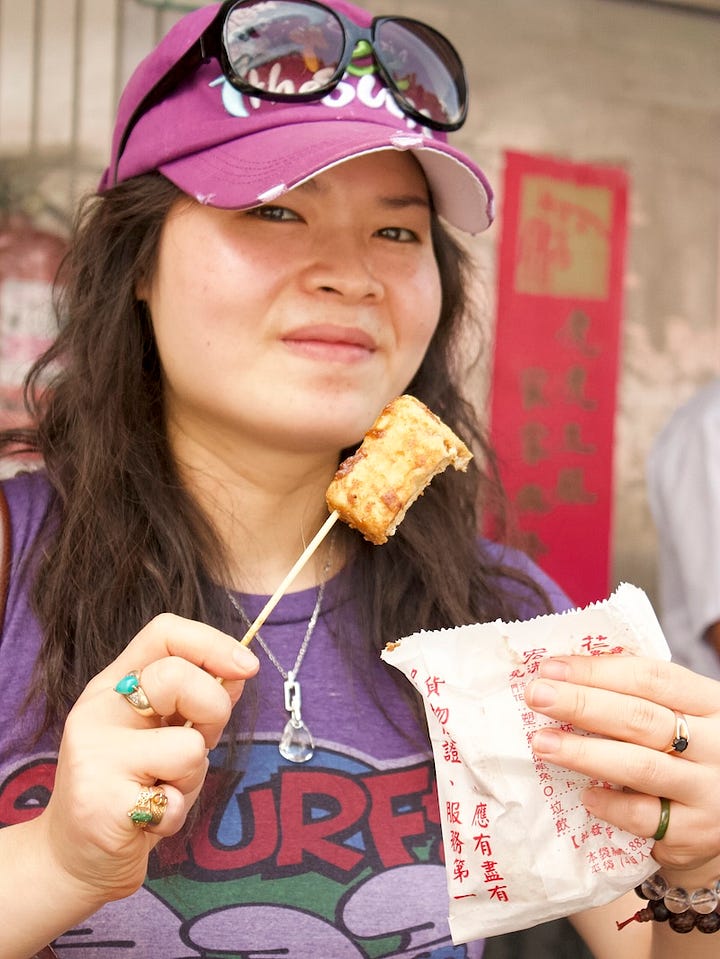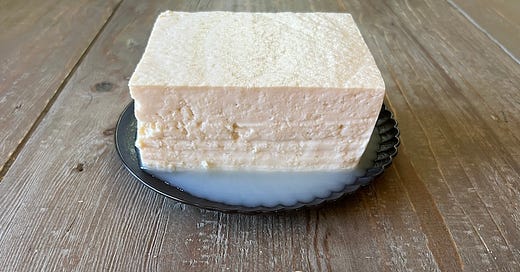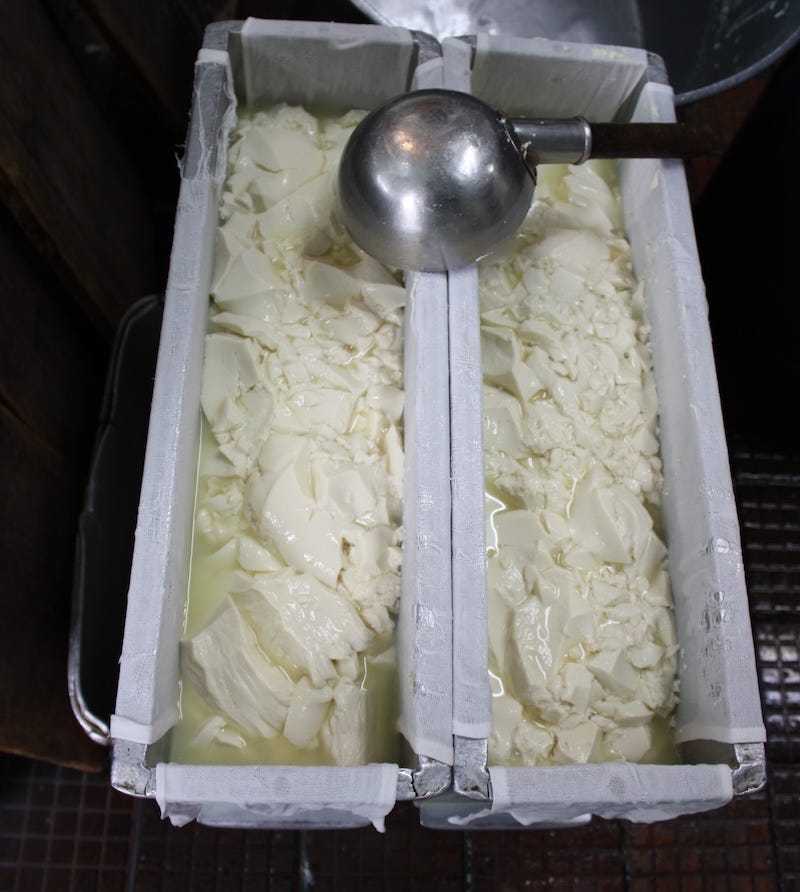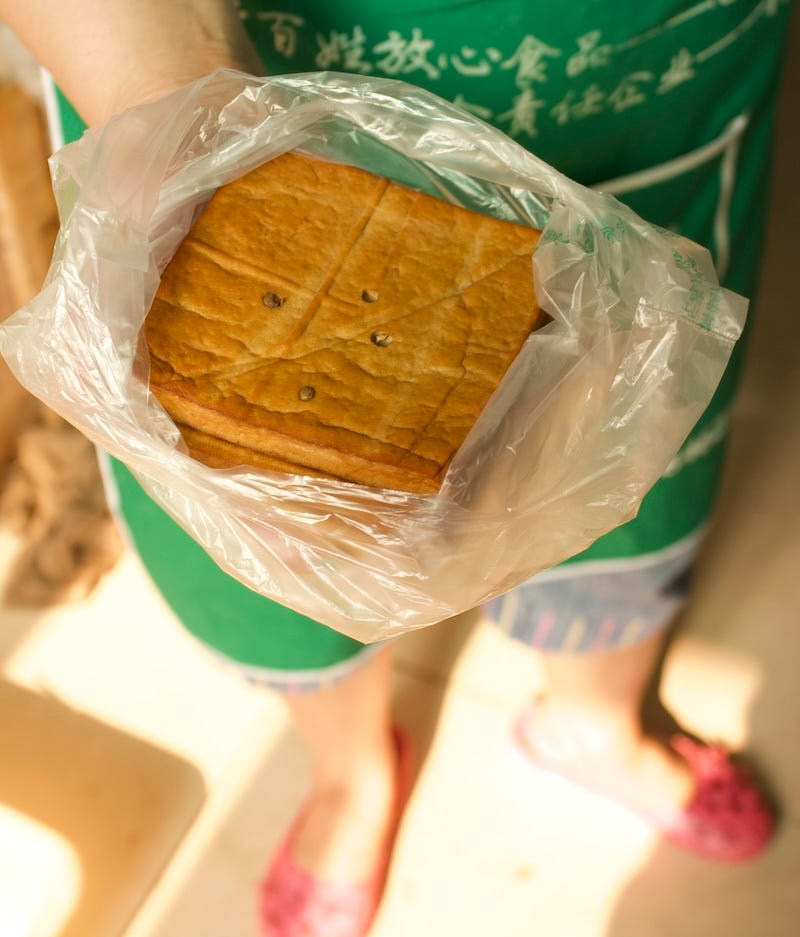Tofu Myths, Truths and Vagaries
What is tofu, tofu health risks, and how to manage water in tofu + a few recipes
Hello PTSFers!
Over 1,000(!) of you recently signed up after PTFS was selected as a 2024 Substack Featured Publication. Woot woot — two years in a row! You could have chosen many other incredible newsletters, but I’m stoked that you chose mine. Welcome.
We’ve been chatting about creating personal paths to better health and negotiating potential challenges to the (ugh!) 3Ms of aging: mid-life, menopause, and memory (loss). Our conversations took jabs at the Mediterranean diet and to a certain extent, the MIND diet for longevity and brain health, too.
Given that backdrop, here’s my silly acronym to capture the gist of our current discussions:
Ha. Ha. BeMINE = Better Mindful Individualized Nourishing Exploration
Down with diet monoculture’s one-size-fits-all approach.
We can determine our own bespoke, doable ways to feed our bodies and souls.
Let’s be curious and flexible about building our healthy lifespans.
Which leads us to tofu — a food that nourishes many people and confounds countless others!
For the next few weeks or so, let’s focus on little bean curd. I’ll offer up foundational information, cooking tips, recipes, plus ideas for you to riff on and create your own tofu magic.
There’s much to learn from Asian tofu foodways because those cuisines have centered tofu for centuries! Why not glean from people in the know?
My aim is to help you add more tofu to your cooking rotation. It’s suppose to be good for us, though some dispute that notion. (Keep reading.)
3 Tofu FAQs
Tofu is a gentle food that has oddly generated both fear and confusion. Since writing my Asian Tofu cookbook, I’ve fielded lots of tofu queries. People typically need clarification about:
What tofu is
Whether tofu is bad for health
How to remove water from tofu
(1) What is tofu? Is tofu a processed food? Is tofu fermented?
Tofu is made from 3 ingredients — dried mature soybeans (not immature edamame!), water, and coagulant. With a very high protein content, soybeans are the vegetable that’s closest to being like an animal!
Tofu is prepared like cheese but the milk is rendered from rehydrated soybeans. You’re not squeezing a cow to get the milk, but rather you’re expelling the silky rich liquid from a finely ground slurry of soybeans and water.
There are many ways to make tofu. When hot soy milk is coagulated with a salt or acid, soy curds separate from clear liquid whey. The curds are transferred to and pressed in molds to make block tofu. My Asian Tofu cookbook field research led me to Tokyo where I visited a neighborhood tofu shop, the source of this photo:
Slightly different are silken tofu and tofu pudding. The curds and whey do not separate during coagulation. The hot soy milk firms up in a mold or pot.
The process involved in making tofu is a natural one. It is transformative but it’s not a laboratory food resulting from the modern industrial processed food complex. Tofu got its start about 2,000 years ago in China. It’s ancient stuff. Yes, I’ve made tofu and you can too.
How to make fresh soy milk and tofu? My recipes and video instructions are at Viet World Kitchen. Access them via this link.
People mostly eat fresh tofu (think mozzarella or ricotta) sold at supermarkets large and small, from mainstream and big box stores to health food markets and specialty grocers.
Like cow’s cheese, tofu can be aged to make fermented tofu. The result is akin to blue cheese — creamy, salty, a bit funky and super savory. Some people eat fermented tofu with rice, porridge, or even spread on bread. I prefer to use its umami base notes to punch up dishes. In Ever-Green Vietnamese, white fermented tofu gets showcased in stir-fried leafy greens, dips, salad dressings and steamed eggs. The fermented tofu recipes in the book are among my favorites.
Red fermented tofu lends crimson color and earthy umami to Chinese roast pork, char siu, and some braises too. The red color comes from red yeast rice.
Stinky tofu is marinated in a special brine to acquire its unusual flavor and aroma. It is not left to age and become creamy. The fermentation isn’t intense. Fried and grilled stinky tofu is popular in Taiwan, where I snapped these pics with Christine Tsai, a member of my Asian Tofu posse:


Tempeh, miso, soy sauce, hoisin and the like involve fermenting soybeans — not tofu. We’ll discuss tofu skin in another dispatch. So much tofu, so little space. 😉
(2) Tofu Health Risks: Does soy feminize men? How does soy consumption affect breast cancer risks?
Like MSG, tofu has gotten a bad rap. Certain misleading anecdotal stories went viral to scare people. There is conflicting, confounding information.
For instance, in 2009, James Price reported developing enlarged breasts (“man boobs”) after drinking soy milk. Men’s Health ran the story and has since removed it from its website, with clarification here. Price gulped up 3 quarts (12 cups) of soy milk per day.
That’s a lot of soy isoflavones. Soy isoflavones are structurally similar to estrogen. Breast cancer growth is extra sensitive to estrogen. So doesn’t it seem plausible that too much soy would raise risks for breast cancer? For many years, women feared tofu.
Studies of thousands of women in China revealed that moderate consumption of soy did not raise breast cancer risks. Soy was shown to actually reduce breast cancer risk in this 2019 study based on data from 300,000 Chinese women, age 30 to 79 year old.
That wasn’t good enough.
In the menopause and midlife post comments, Elise shared her ovarian cancer experience. She also wrote of how some health providers in France agree that soy is good for women, but only if the person possesses lots of Asian DNA. Elise being half Viet didn’t qualify.
What? Turns out, there were observational studies suggesting a link between DNA and soy impact. I initially misread this 2019 study as suggesting the same. Khai thankfully corrected me!
The 2019 study of 220 women arrived at a neutral position:
[from the abstract] Soy foods may protect against breast cancer in Asian but not in Western populations. We examined if the levels of various markers of breast cancer risk and inflammation, as well as the effects of soy food consumption on these markers, differ between Asian and non-Asian premenopausal women in two soy intervention trials. . . . The current findings suggest possible ethnic differences in levels of biomarkers for breast cancer risk but little evidence that Asian women respond differently to soy foods than non-Asian women.
[from conclusions toward the end] As knowledge about the role of early life nutrition and the development of gut microbiota increases, the potential for diverse metabolic pathways of isoflavones in individuals with different ethnic backgrounds and dietary exposures may be clarified. Based on the current evidence, it appears likely that the timing of exposure is the most important determinant of beneficial health effects from soy foods.
The healthcare professional Elise interacted with may have wanted to take a conservative approach and not advise an intake of more soy foods.
I wish these studies were better written for easier interpretation.
My thoughts on these studies:
Let’s examine soy’s impact on non-Asian women who’ve been eating soy for a long time.
Why frame soy as a foreign experience? Countless people across cultures enjoy tofu, tempeh, and edamame. George Washington Carver, Henry Ford, and the blue zone-y Seventh Day Adventists were early tofu champions!
If Asians have been reaping the benefits from a soy-filled life, eating soy is a good long-term approach to health, right? What can be learned?
Cows eat plenty of soybeans. Humans eat beef. Spare some cattle by eating more soybeans. You’ll leapfrog to the front of the food chain. Ha!
If the Mediterranean diet includes tofu, doesn’t that mean it’s okay to regularly enjoy bean curd?
Tofu vs. Soy Protein Isolate
A final soy health note — tofu, soy milk and other tofu-adjacent foods are pretty natural. They are not the same as soy protein isolate added to supplements, protein shakes, meat substitutes, etcetera.
Soy protein isolate is a refined, concentrated form of the soybean. Your average tofu’s soy benefits basically come straight from the ground.
But soy hot dogs and burgers often contain soy protein isolate. TVP (textured vegetable protein) is sometimes made from defatted soy flour. If GMO soy is a concern, make sure the soy isolate in refined foods that you’re eating is non-GMO.
I’m not a fan of concentrated soy. I enjoy natural, genteel soy in the forms of tofu and other simple soy foods. Depending on your hormone situation — concentrated soy can throw things off.
In summary: When consumed at a moderate level, wholesome tofu can have a good or neutral impact on health. To filter conflicting and confusing information on soy, consider the kind of soy people are talking about: whole soy foods or foods made from added soy isolates or soy protein. Then consider your own health situation.
More tofu health info:
Straight Talk about Soy - An excellent explainer from the Harvard T.H. Chan School of Public Health.
The Health Effects of Soy: A Reference Guide for Professionals - A wonky digest at the Nat’l Institutes of Health.
Soy Isoflavones - Get molecular with the Linus Pauling Institute.
Enough of the science! You’re here because you want more tofu in your repertoire. Onwards with a tofu prep basic.
(3) How to get water out of tofu? Do you need a press? What about freezing tofu?
Many cooks think they need to press tofu before using it. Firstly, you don’t have to buy a vice-like press. I don’t own one. I’ve never seen a tofu press in any Asian home kitchen.
Hannah Che, the award-winning author of The Vegan Chinese Kitchen, tells cooks to just forget tofu press contraptions. While attending culinary school in China, she naively asked a teacher if he used a tofu press.
“He looked at me like I was crazy. Why would you want to press the water out?” she said when I chatted with her about tofu for a 2023 New York Times tofu story.
Why such a reaction? Tofu’s innate beauty is partly due to its water content. Tender tofu is moist and luscious, like perfect mozzarella. Sometimes you want that texture and sometimes you don’t.
If your tofu prep ALWAYS eliminates as much water as possible, your beancurd will be very firm and your dishes will be monochromatic. Your tofu life will be limited.
Tofu is multidimensional. It varies in firmness and moisture level. For instance, Chinese-style pressed tofu is a bit chewy, super firm, and dry-ish. You don’t need water to store it. It can be sliced as a nibble or added to dishes. It’s one type of tofu in a vast bean curd world.
Here’s smoked pressed tofu in Chengdu, China:
What about freezing tofu?
Though freezing tofu is popular, I’m not keen on it because:
Freezing tofu can turn lovely tofu into a chewy, soulless sponge.
Moist, tender tofu has richness. When it’s fried, there’s a remarkable contrast between the crisp exterior and soft interior.
There are faster, better methods to remove surface moisture from tofu.
Tofu is a convenient, ready-to-eat protein. Spending time to freeze, then thaw tofu for a simple dish runs counter to tofu’s natural wondrousness.
When do I freeze tofu? When I have an opened container of tofu in the fridge and need to preserve it.
I may also freeze tofu for one of my favorite food writers, Eric Kim. He recently reported on freezing and sheet-pan roasting tofu to a crisp. He checked in with me for his New York Times story and recipe (accessible via my gift links to you).
Fast tofu water removal tips
A good tofu recipe should include info for dealing with moisture. When you’re winging it, you can:
Cut the tofu, soak or briefly poach it in salted water, then drain. Enjoy the tofu dressed with basil and garlic or make mapo tofu, for instance.
Microwave cut or uncut tofu to release water. (Put it in a shallow bowl.)
Let cut tofu sit on a clean non-terry dishtowel for at least 10 minutes or just let it be for hours! (If you use paper towels, you’ll need a triple layer.)
Break tofu into chunks and squeeze in muslin cloth for a dumpling filling, tofu “egg” salad, tofu lasagna or mapo tofu meat sauce.
There many other tofu tips but I’ll pause here.
By now you may have tofu brains (dòu fu nǎo is shorthand for tofu pudding in northern China). If you have tofu questions or feedback, let me know!
May the bean curd be with you.













Love this series! I was watching a video Miyoku Schinner did on air frying tofu and Miyoku commented that she prefers Trader Joe’s tofu. We were just talking about their tofu in our fun Trader Joe’s get together. The recipe looked good. Sometimes I am very content to either fry regular tofu and eat it with soy sauce or have warm or cold silken tofu with soy sauce. (Japanese style-depending upon season)
Hi Andrea,
Love your posts!
However, I believe you are misleading your readers about the benefit of tofu by misinterpreting the two studies you cited.
The Chinese study did not show that eating more soy "actually reduce[d] breast cancer risk." Instead, the study used a meta-analysis of prospective studies to suggest that higher soy consumption "was associated with a 3%... reduced risk of breast cancer."
We all know that meta-analysis is junk science. Also three percent association is not at all meaningful.
More importantly, the study did not control for diets and lifestyles. The women who ate more soy also ate more fruits, vegetables, fish, meat, chicken, dairy, and more calories. They had higher household income. They were more educated. And more of them lived in urban areas. In short, these women were wealthier and healthier. Yet, they didn't have lower risks of cancer!
The other study specifically said "the current evidence offers no substantial support for the hypothesis that women of Asian ethnicity experience distinct effects from soy isoflavones in breast cancer risk."
It also concluded that different ethnic groups with different lifelong diets is "the most important determinant of beneficial health effects from soy foods."
I like soy and tofu. I eat it on a regular basis. I'm not against tofu. Do I think it's a healthy food? Yes, but no more or less than other proteins.
I think with your large platform and dedicated readership, you can be more responsible with your advocacy.